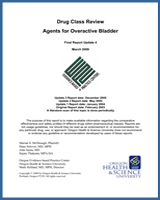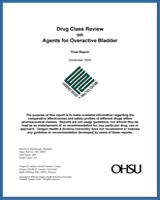NCBI Bookshelf. A service of the National Library of Medicine, National Institutes of Health.
McDonagh MS, Selover D, Santa J, et al. Drug Class Review on Agents for Overactive Bladder: Final Report [Internet]. Portland (OR): Oregon Health & Science University; 2005 Dec.
This publication is provided for historical reference only and the information may be out of date.
Overactive bladder syndrome (OAB) is defined by the International Continence Society (ICS) as a medical condition referring to the urinary symptoms of frequency and urgency, with or without urge incontinence, when appearing in the absence of local pathological factors.1 Nocturia is also commonly present.2 Urinary continence relies heavily upon control and coordination of the smooth muscle found in the wall of the bladder. The effective storage of urine relies on detrusor muscle relaxation and contraction of internal and external sphincters found within the neck of the bladder while voiding is controlled through the contraction of the bladder's detrusor muscle and relaxation of its internal and external sphincters.3 Bladder contraction is mediated via cholinergic muscarinic receptors in bladder smooth muscle. The most common cause of overactive bladder syndrome is detrusor overactivity. Detrusor overactivity may be either idiopathic or neurogenic in origin. A subset of patients with an overactive bladder may complain of urge urinary incontinence. Urge urinary incontinence is the complaint of involuntary leakage accompanied by or immediately preceded by urgency.4, 5
While urge incontinence is not inevitable its incidence does increase with age.6 It has been estimated that overactive bladder affects 20% of community dwelling senior citizens and around 50% of the institutionalized elderly.3, 6 Independent risk factors for the development of overactive bladder include neurologic impairment, immobility, female gender and history of hysterectomy. It is common for urge incontinence to coexist with stress incontinence, especially in women.
Treatment of overactive bladder first requires a clear diagnosis of the type of incontinence associated with OAB. If multiple forms are present it is important to determine which form is dominant. Non-pharmacologic treatment consists of behavioral training (prompted voiding, bladder training, pelvic muscle rehabilitation), transcutaneous electrical nerve stimulation (TENS), catheterization and use of absorbent pads.7 Pharmacological treatment for OAB includes darifenacin, flavoxate hydrochloride, hyoscyamine, oxybutynin chloride, tolterodine tartrate, trospium chloride, scopolamine transdermal, and solifenacin succinate. Flavoxate hydrochloride acts as a direct spasmolytic on smooth muscle and maintains anticholinergic as well as local analgesic properties.3, 8 Oxybutynin chloride has direct antispasmodic action on smooth muscle and inhibits the muscarinic action of acetylcholine on smooth muscle.3, 8, 9 Tolterodine tartrate acts as a competitive muscarinic receptor antagonist.3, 8, 10 Trospium chloride is a quaternary ammonium derivative with predominantly muscarinic action.11 Darifenacin and solifenacin are competitive muscarinic receptor antagonists.12, 13
Anticholinergic agents have been included in a number of expert based or guideline reviews of high risk drugs for the elderly particularly two reviews by Beers et al.14, 15 While these are not systematic reviews they identify drugs with significant potential for adverse effects in the elderly. These reviews do not provide comparative information.
Scope and Key Questions
The scope of the review and key questions were originally developed and refined by the Oregon Evidence-based Practice Center with input from a statewide committee of experts. Subsequently, the key questions were reviewed and revised by representatives of organizations participating in the Drug Effectiveness Review Project (DERP). The participating organizations of DERP are responsible for ensuring that the scope of the review reflects the populations, drugs, and outcome measures of interest to both clinicians and patients. The scope of the current review was approved in May 2005. Two drugs, solifenacin, and darifenacin were approved for use in the US for OAB after September 2004. The participating organizations approved the following key questions to guide this review:
- For adult patients with urinary urge incontinence/overactive bladder, do anticholinergic OAB drugs differ in effectiveness?
- In head to head trials of anticholinergic drugs what is the comparative efficacy?
- What is the comparative efficacy of anticholinergic OAB drugs across active and placebo controlled trials?
- For adult patients with urinary urge incontinence/overactive bladder, do anticholinergic OAB drugs differ in safety or adverse effects?
- Are there subgroups of patients based on demographics (age, racial groups, gender), other medications, or co-morbidities for which one anticholinergic OAB drug is more effective or associated with fewer adverse effects?
- Introduction - Drug Class Review on Agents for Overactive BladderIntroduction - Drug Class Review on Agents for Overactive Bladder
Your browsing activity is empty.
Activity recording is turned off.
See more...

